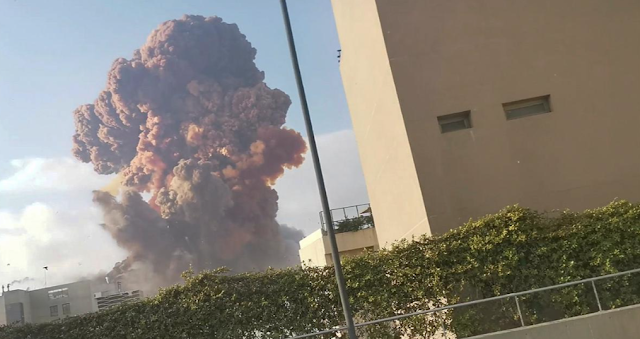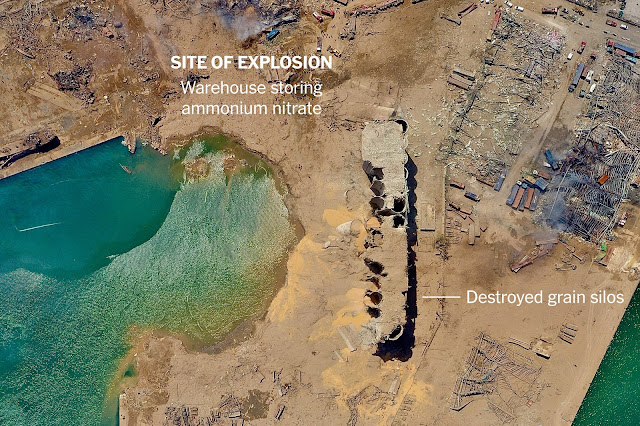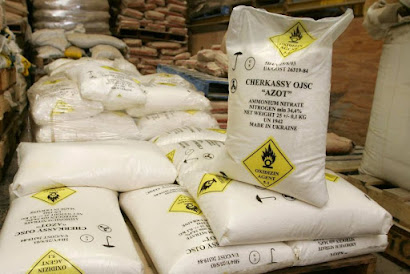2020 Beruit Port Explosion
WHAT WAS THAT..?
(2020 Beruit Port Explosion)

The Port of Beirut is the main port in Lebanon on the eastern part of the Saint George Bay on Beirut's northern Mediterranean coast, west of the Beirut River. It is one of the largest and busiest ports in the Eastern Mediterranean.
Explosion
on 4th August 2020 after 8:30PM(IST) a series of explosions took place at the port of Beirut. Shortly after 8:30 firefighters were dispatched to extinguish a warehouse fire at the port.
- The first smaller explosion sends a cloud of smoke above the fires and created flashes of light said at resemble fireworks.
- the second explosion was much more substantial and occurred at about8:38PM rocked central Beirut and sent a red-orange cloud into the air, briefly surrounded by a white condensation cloud. Nitrogen oxide causes the orange-red color in the ammonium nitrate explosion. The main explosion was linked to approximately 2750tons of ammonium nitrate that had been taken with authority by the govt from the abandoned ship and stored in the port without proper safety measures for the six years. The second blast was felt in Northern Israel and Cyprus (240Kms away).
What is Ammonium Nitrate that exploded?
Ammonium Nitrate is a Chemical compound with Chemical formulae NH3 NO3. It is predominantly used in agriculture as a high nitrogen fertilizer. (Global production 21.6 million tons in 2017)
Its major use as a component of explosive mixtures in mining, quarrying and civil construction.It is the major component of explosives like ANFO and IEDs.Ammonium nitrate is not the explosive in the form it is commonly sold. However, it readily forms explosive mixtures with varying properties when combined with varying properties .when combined with primary explosives like azides and fuel oils.
Many countries are phasing out its use in consumer applications due to concerns over its potential for misuse.
Damage
- Damage estimates are in the billions of dollars, some estimates reaching $15 billion.
- witnesses said that homes as far as 10 km away were damaged by the blast and up to 3,00,000 people were left homeless by the explosion.
- The grain elevator, the city second largest was destroyed exacerbating food shortages caused by the COVID19 pandemic and a severe financial crisis. About 15,000 tonnes of grain were destroyed, representing 85% of the city's grain reserves, and leaving the country with less than a month's worth of grain in reserve.
- Some Embassies sustained heavy damage. The embassies of Argentina, Australia, Finland, Cyprus, and the Netherlands, which were close to the blast, sustained heavy damage. The South Korean embassy, 7.3 kilometers (4 1⁄2 miles) from the blast site, reported minor damage to two windows within the embassy building. The Kazakh, Russian, Hungarian, Romanian, and Turkish embassies also reported minor damage.
The story of MV Rhosus
On 23 September 2013, the Moldovan flagged cargo ship MV Rhosus, owned by Russian businessman Igor Grechushkin, set sail from Batumi, Georgia, to Beira, Mozambique, carrying 2,750 tonnes of ammonium nitrate fertilizer. In October, it was forced to port in Beirut with engine problems. After inspection by port state control, the Rhosus was found unseaworthy, and it was forbidden to set sail. The owner of the Rhosus, the Cyprus-based Russian businessman Igor Grechushkin went bankrupt, and after the charterers lost interest in the cargo, the owner abandoned the ship. By order of the judge, the dangerous cargo was brought ashore in 2014 and placed in Hangar 12 at the port in unsuitable climatic conditions, where it remained for the next six years.
Damage in shipping
The cruise ship Orient Queen, berthed nearby,
suffered extensive damage. Two members of the crew were killed, and several on
board were injured. The ship capsized overnight and sank in the port after receiving massive damage
The Bangladesh Navy corvette BNS Bijoy,
which participated in the United Nations Interim Force in Lebanon, was
also damaged. The ship was very close to the site of the explosion.
The livestock carrier Jouri was
close to the site of the explosion; its AIS stopped broadcasting at
the time of the explosion. The cargo ship Mero Star was
severely damaged. The cargo ship Raouf H was closest to the
site of the explosion. AIS from these ships stopped broadcasting at the
time of the explosion.
Hapag-Lloyd's
offices in Beirut were destroyed in the explosion. CMA CGM's offices were
severely damaged. One of its employees was reported missing and two were
severely injured. The container ship CMA CGM Lyra was 1.5
kilometers from the site of the explosion and was undamaged.
International Response
French President Emmanuel Macron visited Beirut personally on 6 August and pledged support. He was the first foreign head of state to visit the city following the disaster.

















Comments
Post a Comment
Please give your valuable advice and do comment.